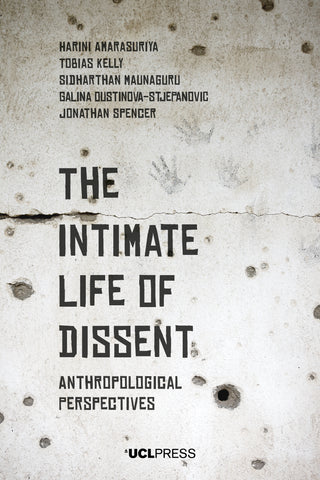Book review of Amarasuriya, Harini, et al. The Intimate Life of Dissent: Anthropological Perspectives. UCL Press, 2020.
The Intimate Life of Dissent examines practices of refusal and resistance through the friendships, kinships and solidarities which withstand and obstruct them. The authors of this edited volume define dissent as a particular form of attachment which draws people in and out of relations and produces its own kind of conformity. In so doing, they separate dissent from its associations with ideas of agency, personhood and progress. The authors of this volume leave behind discourses of resistance and their romantic undertones to focus instead on the intimate ties, tensions and contradictions which inform the possibility for dissent and the shapes it takes. Far from acting out of individual consciousness, the dissenters introduced throughout the nine chapters of this volume are enmeshed within intimate and sometimes conflicting attachments. Through its focus on the affinities and enmities which run across dissident trajectories, this volume offers a valuable contribution to the study of activism and political anthropology more broadly.
Dissenters are less romantic individuals moved by their individual conscience to fight against injustices than people caught up in the constraints of intimate relations and driven by particular affinities.
 In the first core chapter, Galina Oustinova-Stjepanovic draws on the written records of political activist Natalya Gorbanevskaya to retrace the political aftermath of the Red Square protest of August 1968 against the military invasion of Czechoslovakia by Soviet and Warsaw Pact troops. She takes togetherness and estrangement from Soviet discourse as political practices through which dissidents openly challenge the totalitarian aspirations of the Soviet state. Dissent emerges from the cultivation of activist relationships against the abstract ‘we’ of the Soviet nation. In chapter 3, Erica Weiss takes up the case of dissent among ultra-Orthodox Jewish Israeli and liberal Jewish Israeli peace activists to shed light on what she calls “dissent without resistance”. Drawing on interviews with ultra-Orthodox peace activists, Weiss calls for the recognition of illiberal forms of dissent which do not fit the liberal standards of rebellion and resistance but operate within the conservative frameworks of tradition and continuity. In the next chapter, Serra Hakyemez turns to the socialities of Kurdish activists in Turkish prisons to argue that prisoners cultivate dissident identities within carceral milieus. She mobilizes friendship as a concept to understand the endurance of dissident politics in the midst of state repression. From this perspective, friendship is a political relationship cultivated among prisoners to sustain both everyday life behind bars and Kurdish resistance against the Turkish state. In chapter 5, Harini Amarasuriya and Jonathan Spencer retrace the political and personal life of Joe Seneviratne, a Sri Lankan activist, to shed light on the conflicting obligations – to friends, comrades, party members and family – which run across many activist attachments. Drawing on fieldwork in Colombo, Sri Lanka, and interviews with Seneviratne himself, the authors inscribe political commitments within conflicting social relationships and suggest that dissent can translate relations and affects, turning friends into family and love into loyalty. In the next chapter, Tobias Kelly draws on historical archives to shed light on the experiences of British conscientious objectors to military service during the Second World War. While claims of conscience can form the grounds of dissident socialities, he suggests, they can also elicit mistrust and make for awkward relationships. Throughout his chapter, Kelly shows how even for conscientious objectors, who often figure as archetypes of liberal freedom, conscience relates more to a social duty than to an expression of freewill: an obligation toward family, friends, or nation, that is at once personal and shaped by circulating affects, like fear, anger, or pride. In chapter 7, Sidharthan Maunaguru turns to Sri Lankan Tamil former political activists who were active in the 1970s and 80s to suggest that maintaining friendships across political divides can also be thought of in terms of dissent. Moving past the division in political theory between friendship and enmity, Maunaguru draws on interviews with activists from opposed Tamil movements to show that public enmity can coexist with private attachments. Friendship in this chapter refers to the cultivation of an ethics of care and protection across political boundaries. In chapter 8, Carole McGranahan tells the story of the Pangdatsang family who became prominent in the Tibetan socio-political landscape during the first half of the twentieth century. The author traces the particular trajectory of the Pangdatsang brothers from eastern Tibet to the intimate circles of the Dalai Lama to shed light on submission and refusal as two complementary forms of dissent. Collecting details from the history of the Pangdatsang family, McGranahan argues that the brothers rose to power through a subtle articulation of submission to Tibetan elites – as strategic loyalty – and refusal – as public rejection of the way things are. In the final chapter, Doreen Lee focuses on the production of activist archives and dissident documents in Indonesia during the final decade of the New Order (1988-98). She takes propaganda fliers and prison letters as two forms of activist writings and traces their production, circulation, and consumption to show that dissident affinities are produced and circulated through everyday practices of writing, copying, and reading texts. Political intimacies here rely on an infrastructure of dissent made of mimeograph machines, copy shops and toners. Throughout these eight chapters, the authors of this volume convincingly make the case for socially-embedded practices of dissent. From their perspective, dissenters are less romantic individuals moved by their individual conscience to fight against injustices than people caught up in the constraints of intimate relations and driven by particular affinities.
In the first core chapter, Galina Oustinova-Stjepanovic draws on the written records of political activist Natalya Gorbanevskaya to retrace the political aftermath of the Red Square protest of August 1968 against the military invasion of Czechoslovakia by Soviet and Warsaw Pact troops. She takes togetherness and estrangement from Soviet discourse as political practices through which dissidents openly challenge the totalitarian aspirations of the Soviet state. Dissent emerges from the cultivation of activist relationships against the abstract ‘we’ of the Soviet nation. In chapter 3, Erica Weiss takes up the case of dissent among ultra-Orthodox Jewish Israeli and liberal Jewish Israeli peace activists to shed light on what she calls “dissent without resistance”. Drawing on interviews with ultra-Orthodox peace activists, Weiss calls for the recognition of illiberal forms of dissent which do not fit the liberal standards of rebellion and resistance but operate within the conservative frameworks of tradition and continuity. In the next chapter, Serra Hakyemez turns to the socialities of Kurdish activists in Turkish prisons to argue that prisoners cultivate dissident identities within carceral milieus. She mobilizes friendship as a concept to understand the endurance of dissident politics in the midst of state repression. From this perspective, friendship is a political relationship cultivated among prisoners to sustain both everyday life behind bars and Kurdish resistance against the Turkish state. In chapter 5, Harini Amarasuriya and Jonathan Spencer retrace the political and personal life of Joe Seneviratne, a Sri Lankan activist, to shed light on the conflicting obligations – to friends, comrades, party members and family – which run across many activist attachments. Drawing on fieldwork in Colombo, Sri Lanka, and interviews with Seneviratne himself, the authors inscribe political commitments within conflicting social relationships and suggest that dissent can translate relations and affects, turning friends into family and love into loyalty. In the next chapter, Tobias Kelly draws on historical archives to shed light on the experiences of British conscientious objectors to military service during the Second World War. While claims of conscience can form the grounds of dissident socialities, he suggests, they can also elicit mistrust and make for awkward relationships. Throughout his chapter, Kelly shows how even for conscientious objectors, who often figure as archetypes of liberal freedom, conscience relates more to a social duty than to an expression of freewill: an obligation toward family, friends, or nation, that is at once personal and shaped by circulating affects, like fear, anger, or pride. In chapter 7, Sidharthan Maunaguru turns to Sri Lankan Tamil former political activists who were active in the 1970s and 80s to suggest that maintaining friendships across political divides can also be thought of in terms of dissent. Moving past the division in political theory between friendship and enmity, Maunaguru draws on interviews with activists from opposed Tamil movements to show that public enmity can coexist with private attachments. Friendship in this chapter refers to the cultivation of an ethics of care and protection across political boundaries. In chapter 8, Carole McGranahan tells the story of the Pangdatsang family who became prominent in the Tibetan socio-political landscape during the first half of the twentieth century. The author traces the particular trajectory of the Pangdatsang brothers from eastern Tibet to the intimate circles of the Dalai Lama to shed light on submission and refusal as two complementary forms of dissent. Collecting details from the history of the Pangdatsang family, McGranahan argues that the brothers rose to power through a subtle articulation of submission to Tibetan elites – as strategic loyalty – and refusal – as public rejection of the way things are. In the final chapter, Doreen Lee focuses on the production of activist archives and dissident documents in Indonesia during the final decade of the New Order (1988-98). She takes propaganda fliers and prison letters as two forms of activist writings and traces their production, circulation, and consumption to show that dissident affinities are produced and circulated through everyday practices of writing, copying, and reading texts. Political intimacies here rely on an infrastructure of dissent made of mimeograph machines, copy shops and toners. Throughout these eight chapters, the authors of this volume convincingly make the case for socially-embedded practices of dissent. From their perspective, dissenters are less romantic individuals moved by their individual conscience to fight against injustices than people caught up in the constraints of intimate relations and driven by particular affinities.
One of the book’s main contributions is to draw a distinction between dissent and subversion by taking dissent as a form of refusal that can sprout from diverse moral grounds. While liberal traditions figure dissenters as individual freedom chasers, other cultures of dissent consider refusal as a dividual practice enmeshed within dense socialities and obligations. From this perspective, dissent can be illiberal, or conservative. On the other hand, loyalty can feed practices of dissent when it expresses bonds of kinship, friendship, or solidarity across political boundaries. This conceptual distinction is fruitful, as it can help us recognize both the conformist potential of activism and the subversive aspects of conservative practices. There are times in the book where clarity recedes, however, and the reader is left thinking that dissent could virtually take any form, as long as people in their particular cultural landscape interpret it as such. Moreover, while many of the authors in this volume convincingly show how intimate relations can fuel political dissidence, more attention could have been paid to the smothering potential of intimacy; to instances where family ties or friendships stifle activist aspirations. That said, this volume makes an important contribution to political anthropology by examining dissidence through the lenses of intimacy, friendship, solidarity and enmity. It will be of interest to anthropologists, sociologists and historians interested in political movements and activism.
Featured Image by Towfiqu barbhuiya (courtesy of pexels.com)



